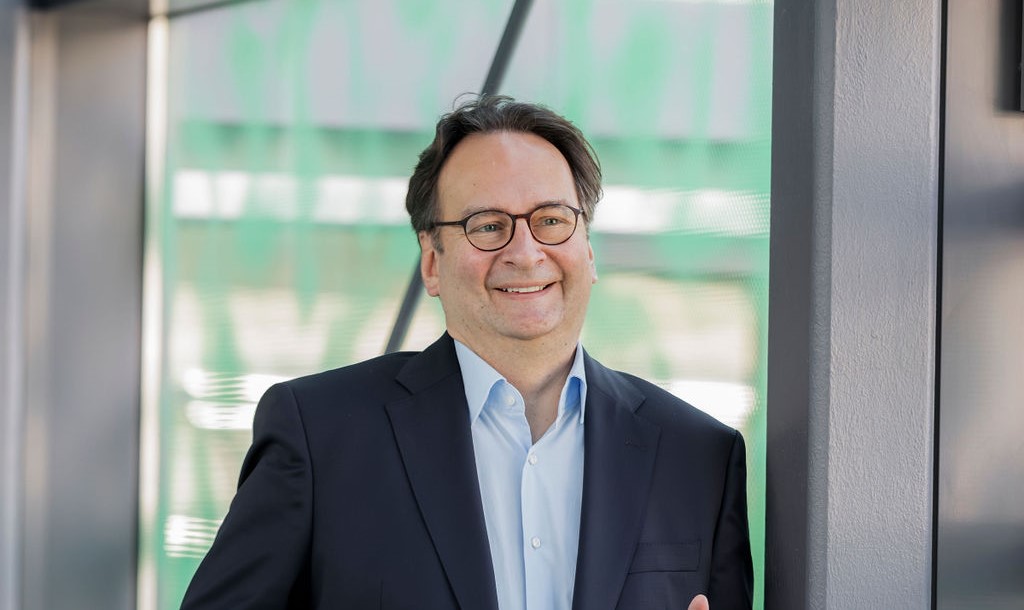New cancer research building: Boosting innovation in oncology
For over 20 years, Vienna has been a central pillar in our global oncology research network. A new building now provides more space and the latest technologies to get closer to our goal of curing cancer. It underpins our long-lasting commitment to partnerships and collaborations.
In September 2024, our new cancer research building in Vienna was officially inaugurated. It is a state-of-the-art, energy-efficient, and highly sustainable building that provides space for more than 150 researchers. Additional capacities that will help us strengthen our pipeline and develop medicines patients and their loved ones will benefit from.
Behind the scenes of our new cancer research center in Vienna
Honoring an exceptional researcher: Angelika Amon
Our new cancer research building is named after an exceptional scientist: Angelika Amon. She began her scientific career in 1987 at the Institute of Molecular Pathology (IMP) in Vienna and then moved to the United States in 1994, where she worked at the Massachusetts Institute of Technology (MIT). Despite her early death in 2020, she leaves behind an impressive legacy. Her work has fundamentally changed the way we understand cellular processes and will continue to influence biomedical research.
Norbert Kraut, Head of Cancer Research at Boehringer Ingelheim, and Jan-Michael Peters, Scientific Director of the Institute of Molecular Pathology (IMP) in Vienna, look back on the life and work of the outstanding scientist Angelika Amon and discuss the importance of collaboration between industry and academia.
Angelika passed away after a long fight with cancer. During her career, she made tremendous contributions to a better understanding of cell processes playing a role in this disease. Where can we pick up her work today?
Norbert Kraut: She laid important scientific foundations for many areas, for example for our understanding of the cell cycle. She discovered that errors in this process can lead to an anomaly in which a cell has an unusual number of chromosomes. This is also called aneuploidy – Down syndrome (trisomy-21) is a well-known example of this. In oncology research, her findings help to understand how cancer arises at the cellular level. This could potentially lead to new approaches in the diagnosis and treatment of different types of cancer.
Jan-Michael Peters: Angelika did pioneering work in many ways – real experimental basic research. Much is still in its infancy, but there’s enormous potential.
Partnering for success: Strengthening collaboration to advance research
Angelika was also an advocate for private-public collaborations. Jan-Michael, as scientific director of the IMP, what does it mean to you that Boehringer funds two-thirds of IMP research?
Jan-Michael Peters: This stable funding by Boehringer Ingelheim allows us to pursue particularly important questions in basic science even if these are technically very difficult to answer. This freedom enables us to embark on risky projects, which have a high potential to lead to fundamental discoveries. This freedom attracts many young and talented scientists from all over the world to come and work with us.
And what does Boehringer Ingelheim get out of this partnership?
Norbert Kraut: Well-known examples such as the discovery of antibiotics or the CRISPR genetic scissors came to light due to curiosity and peculiar research approaches. This shows that it takes a certain openness and impartiality to achieve such breakthroughs. The priorities that the IMP follows up on, be it structural biology, developmental biology or immunology and oncology research are wisely chosen. Building on their understanding of fundamental biology is of course our hope. We are in close exchange and share knowledge, ideas and technologies, but we don’t define any requirements to the research institute.
Collaborating with the Institute of Molecular Pathology (IMP) in Vienna
In close exchange – what does that mean exactly?
Norbert Kraut: Currently, we have about 30 collaboration projects between Boehringer Ingelheim and the IMP. Our aim is to translate IMP’s basic research into potential new medicines. For instance, their findings on aberrant biological processes occurring in cancer, gave us starting points to develop new therapies.
Jan-Michael Peters: The close cooperation also means that many young talents who have worked at the IMP at some point in their career decide to join Boehringer Ingelheim - precisely because they perceive the cooperation as enriching. In the company, they can then use the training and expertise from their basic research at the IMP to contribute to the development of new therapies.
Partnering to deliver the next breakthrough
Finally, a look into the future: how and where will we make the next breakthrough in research?
Norbert Kraut: We want to achieve breakthroughs in areas with the highest unmet medical need. And this can only be achieved through impactful cooperation and partnerships. The cooperation with the IMP is a good example of this. And so is our “radar system” for new innovations, Research Beyond Borders, with which we explore new ideas and technologies worldwide, or the Grass Roots initiatives, in which we promote networking and mentoring with other partner companies. Collaboration is key.
Jan-Michael Peters: When and where we will achieve the next breakthrough discoveries cannot be predicted, this lies in the nature of basic research. However, I am convinced that such breakthroughs will be achieved. The fact that many diseases cannot be cured today is in many cases not because these diseases are principally untreatable but that we know too little about their origin. This is where basic research is needed.
Learn more about the Institute of Molecular Pathology (IMP)
The Research Institute of Molecular Pathology in Vienna is a biomedical basic research institute, supported by Boehringer Ingelheim. With over 200 scientists from 40 countries, the IMP is dedicated to the scientific exploration of fundamental molecular and cellular mechanisms underlying complex biological phenomena. The IMP is part of the Vienna BioCenter, one of the most dynamic centers for life sciences in Europe with over 2800 employees from 80 countries in six research institutions, two universities, and 35 biotech companies.
Related Content


